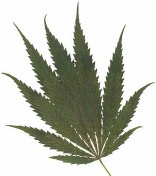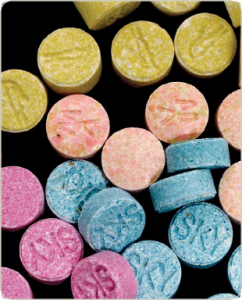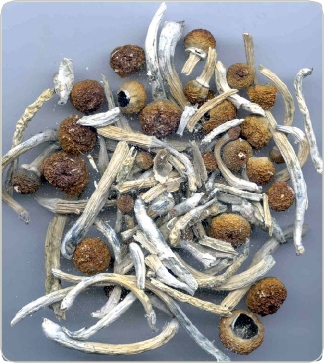3.9 Examples of Hallucinogens
What is Cannabis?
Cannabis is a hallucinogen, produced by the cannabis sativa plant. Cannabis contains hundreds of chemical substances. More than 100 chemicals, called cannabinoids, have been identified as specific to the cannabis plant. THC (delta-9-tetrahydrocannabinol) is the main psychoactive cannabinoid and is most responsible for the “high” associated with cannabis use. Another cannabinoid is cannabidiol (CBD). CBD has little or no psychoactive effects, so you do not feel high. CBD counteracts some of the negative effects of THC.[1]
What is Hashish?
Hashish and hashish oil are substances made from the cannabis plant that is like marijuana, only stronger. Hashish consists of the THC-rich resinous material of the cannabis plant, which is collected, dried, and then compressed into a variety of forms, such as balls, cakes, or cookie-like sheets. Pieces are then broken off, placed in pipes or mixed with tobacco and placed in pipes or cigarettes, and smoked. Hashish oil is produced by extracting the cannabinoids from the plant material with a solvent. The color and odor of the extract will vary, depending on the solvent used.
What is its origin?
The history of cannabis is lengthy, suffice it to say “humans have utilized cannabis products in various forms throughout recorded history.“[2] Cannabis is currently grown all over the world and it can be cultivated in both outdoor and indoor settings.

What does it look like?
Marijuana is a dry, shredded green/brown mix of flowers, stems, seeds, and leaves from the Cannabis sativa plant. The mixture typically is green, brown, or gray in color and may resemble tobacco. It has a strong smell.
How is it administered?
Marijuana is usually smoked as a cigarette (a joint) or in a pipe or bong. It is also smoked in blunts, which are cigars that have been emptied of tobacco and refilled with marijuana, sometimes in combination with another drug. Marijuana is also mixed with foods or brewed as a tea (ganja tea, used in Jamaica).[3] It is also sold in edible form, in products from candy to salad oils to baked goods. According to the Canadian Tobacco, Alcohol and Drugs Survey in 2015, 3.6 million (or 12%) of Canadians used cannabis.[4] Since becoming legal in 2019, that number may be different due to confidence in self reporting.
What is its effect on the mind?
When marijuana is smoked, the THC passes from the lungs and into the bloodstream, which carries the chemical to the organs throughout the body, including the brain. In the brain, the THC connects to specific sites called cannabinoid receptors on nerve cells and influences the activity of those cells. Many of these receptors are found in the parts of the brain that influence pleasure, memory, thought, concentration, sensory and time perception, and coordinated movement. The short-term effects of marijuana include feelings of euphoria, anxiousness, even fear, depending on the person. Others have indicated feelings of distorted perception, difficulty in thinking and problem-solving, and loss of coordination.
The effect of marijuana on perception and coordination are responsible for serious impairments in learning, associative processes, and psychomotor behavior (for example driving abilities). Long-term, regular use can lead to physical dependence and withdrawal following discontinuation, as well as psychological dependence. Clinical studies show that the physiological, psychological, and behavioral effects of marijuana vary among individuals and present a list of common responses to cannabinoids, as described in the scientific literature:
- Dizziness, nausea, tachycardia, facial flushing, dry mouth, and tremor initially
- Merriment, happiness, and even exhilaration at high doses
- Disinhibition, relaxation, increased sociability, and talkativeness
- Enhanced sensory perception, giving rise to increased appreciation of music, art, and touch Heightened imagination leading to a subjective sense of increased creativity
- Time distortions
- Illusions, delusions, and hallucinations are rare except at high doses
- Impaired judgment, reduced coordination, and ataxia, which can impede driving ability or lead to an increase in risk-taking behavior
- Emotional liability, the incongruity of affect, dysphoria, disorganized thinking, inability to converse logically, agitation, paranoia, confusion, restlessness, anxiety, drowsiness, and panic attacks may occur, especially in inexperienced users or in those who have taken a large dose
- Increased appetite and short-term memory impairment are common
What is its effect on the body?
Short-term physical effects from marijuana use may include sedation, bloodshot eyes, increased heart rate, coughing from lung irritation, increased appetite, and decreased blood pressure. People who smoke marijuana may experience health problems such as bronchitis, emphysema, and bronchial asthma. Extended use may cause suppression of the immune system. Withdrawal from chronic use of high doses of marijuana causes physical signs including a headache, shakiness, sweating, and stomach pains and nausea. Withdrawal symptoms also include behavioral signs such as restlessness, irritability, sleep difficulties, and decreased appetite. No deaths from overdose of marijuana have been reported.
What is its legal status in Canada?[5]
On October 17, 2018, the Cannabis Act came into force. Adults who are 18 or 19 years or older (depending on province or territory) are able to:
- possess up to 30 grams of legal dried cannabis, or its equivalent in non-dried form, in public
- share up to 30 grams of dried cannabis or its equivalent with other adults
- buy cannabis products from a provincial or territorial retailer
- grow up to 4 plants per residence (not per person) for personal use:
- from legally acquired seeds or seedlings
- depending on the province or territory
In the news: watch
New cannabis products: What Canadians need to know[6] by Health Canada and the Public Health Agency of Canada.
Available via the Healthy Canadians YouTube channel.
What is Ecstasy/MDMA?
MDMA acts as both a stimulant and psychedelic, producing an energizing effect, distortions in time and perception, and enhanced enjoyment of tactile experiences. People use it to reduce inhibitions and to promote euphoria, feelings of closeness, empathy, and sexuality. Although MDMA is known among users as ecstasy, researchers have determined that many ecstasy tablets contain not only MDMA but also a number of other drugs or drug combinations that can be harmful, including fentanyl.
What is its origin?
The origins of MDMA have been challenged; however recent studies have shown that the German company Merck mentioned MDMA for the first time in files from 1912.[7] MDMA was tested by Merck as a blood-clotting medicine in the 1960’s; not as an appetite suppressant as has been debunked by both scholars and Merck. In 1960, the first official recipe for ecstasy appeared in a scientific journal and by 1970 MDMA was being used in North America.[8]
What does it look like?
MDMA is mainly distributed in tablet form; MDMA tablets are sold with logos, creating brand names for people to seek out. MDMA is also distributed in capsules, powder, and liquid forms.

How is it administered?
MDMA use mainly involves swallowing tablets, which are sometimes crushed and snorted, occasionally smoked but rarely injected. MDMA is also available as a powder.
What is its effect on the mind?
MDMA mainly affects brain cells that use the chemical serotonin to communicate with each other. Serotonin helps to regulate mood, aggression, sexual activity, sleep, and sensitivity to pain. Clinical studies suggest that MDMA may increase the risk of long-term problems with memory and learning. MDMA causes changes in perception, including euphoria and increased sensitivity to touch, energy, sensual and sexual arousal, need to be touched, and need for stimulation.
Some unwanted psychological effects include: Confusion, anxiety, depression, paranoia, sleep problems, and drug craving. All these effects usually occur within 30 to 45 minutes of swallowing the drug and usually last 4 to 6 hours, but they may occur or last weeks after ingestion.
What is its effect on the body?
People who take MDMA may experience some of the same effects as those who use stimulants such as cocaine and amphetamines. These include increased motor activity, alertness, heart rate, and blood pressure. In high doses, MDMA can interfere with the body’s ability to regulate temperature. On occasions, this can lead to a sharp increase in body temperature (hyperthermia), resulting in liver, kidney, and cardiovascular system failure, and death. Because MDMA can interfere with its own “metabolism” (its breakdown within the body), potentially harmful levels can be reached by repeated drug use within short intervals. Studies suggest the chronic use of MDMA can produce damage to the serotonin system.
What is its legal status in Canada?
MDMA is a Schedule III drug under the Controlled Substances Act.
In the news: READ
Vancouver psychedelics company gets Health Canada greenlight for MDMA therapy study by Jon Hernandez, posted to CBC News British Columbia July 14, 2021[9]
What is LSD?
LSD is a hallucinogen that has no accepted medical use in treatment in Canada.
What is its origin?
LSD was synthesized in 1943 by Albert Hofmann at Sandoz Pharmaceutical Laboratories in Switzerland.[10] It was used over the next fifteen years in a variety of applications from treating other substance use disorders like alcohol as well as mental health disorders like schizophrenia.[11] The substance fell from favor as a method of treatment for any disorder and was added to the CDSA.
What does it look like?
LSD comes in tablets, capsules, and occasionally in liquid form. It is an odorless and colorless substance with a slightly bitter taste. LSD is often added to absorbent paper, such as blotter paper, and divided into small decorated squares, with each square representing one dose.
How is it admininisterd?
LSD is generally taken orally.
What is its effect on the mind?
During the first hour after ingestion, users may experience visual changes with extreme changes in mood. While hallucinating, the user may suffer impaired depth and time perception accompanied by a distorted perception of the shape and size of objects, movements, colors, sound, touch, and the user’s own body image. The ability to make sound judgments and see common dangers is impaired, making the user susceptible to personal injury. It is possible for users to suffer acute anxiety and depression after an LSD “trip” and flashbacks have been reported days, and even months, after taking the last dose.
What is its effect on the body?
The physical effects include dilated pupils, higher body temperature, increased heart rate and blood pressure, sweating, loss of appetite, sleeplessness, dry mouth, and tremors.
What is its legal status in Canada?
LSD is a Schedule III substance under the CDSA.
In the news: Read
LSD. Good for your health? This Canadian researcher says it just might be — if you take enough by Omar Mosleh posted February 28, 2020 to the Toronto Star.[12]
What are Peyote and Mescaline?
Peyote is a small, spineless cactus. The active ingredient in peyote is the hallucinogen mescaline.
What is its origin?
Peyote has been used by Indigenous peoples in North and South America as a part of their religious rites for thousands of years. A recent study has shown prehistoric use of peyote by native North Americans and a radiocarbon study dated the dried cacti to the time interval 3780–3660 BCE.[13] Mescaline can be extracted from peyote or produced synthetically.

What does it look like?
The top of the peyote cactus is referred to as the “crown” and consists of disc-shaped buttons that are cut off. These buttons are called mescal buttons.
How is it admininstered?
The fresh or dried buttons are chewed or soaked in water to produce a liquid. Peyote buttons may also be ground into a powder that can be placed inside gelatin capsules to be swallowed, or smoked with a leafy material such as cannabis or tobacco.
What is its effect on the mind?
Peyote and mescaline will cause varying degrees of illusions, hallucinations, altered perception of space and time, and altered body image. People may also experience euphoria, which is sometimes followed by feelings of anxiety.
What is its effect on the body?
Following the consumption of peyote and mescaline people may experience: Intense nausea, vomiting, dilation of the pupils, increased heart rate, increased blood pressure, a rise in body temperature that causes heavy perspiration, headaches, muscle weakness, and impaired motor coordination. It is said with the use of mescalin the hangover comes first, as it induces hours of nausea and often vomiting before the hallucinations begin.[14]
What is its legal status in Canada?
Peyote and mescaline are Schedule III substances under the CDSA. In the United States a specific exemption has been granted to the Native American Church for ‘bona fide traditional ceremonial purposes”.[15]
In the news: READ
Psychedelic use spreads in B.C. native community posted August 2, 2011 to CBC News British Columbia.[16]
What is Psilocybin?
Psilocybin is a chemical obtained from certain types of fresh or dried mushrooms.
What is its origin?
Psilocybin mushrooms are found in Southern and Northern American countries. Evidence from antiquity suggests psilocybin mushrooms were used by different, geographically separated ancient cultures,[17] with the most prominent evidence from ancient meso-American cultures, who described psilocybin mushrooms as “teonanacatl” (“flesh of god”).[18]

What does it look like?
Mushrooms containing psilocybin are available fresh or dried and have long, slender stems topped by caps with dark gills on the underside. Fresh mushrooms have white or whitish-gray stems; the caps are dark brown around the edges and light brown or white in the center. Dried mushrooms are usually rusty brown with isolated areas of off-white.
How is it administered?
Psilocybin mushrooms are ingested orally. They may also be brewed as a tea or added to other foods to mask their bitter flavor.
What is its effect on the mind?
The psychological consequences of psilocybin use include hallucinations and an inability to discern fantasy from reality. Panic reactions and psychosis also may occur, particularly if a person ingests a large dose.
What is its effect on the body?
The physical effects include nausea, vomiting, muscle weakness, and lack of coordination.
What is its legal status in Canada?
Psilocybin is a Schedule III substance under the Controlled Substances Act.
In the news: Read
New U of C research position 1st in Canada to focus on psychedelic drug therapy for mental health by The Canadian Press , posted: June 9, 2021 to CBC News Alberta.[19]
Chapter Credit
Adapted from Unit 3.9 in Drugs, Health & Behavior by Jacqueline Schwab. CC BY-NC-SA. Updated with Canadian Content.
Image Credit
Marijuana Plant, MDMA/Ecstasy pills, Peyote Cactus, and Psilocybin Mushrooms, Drugs of Abuse from: U.S. Department of Justice Drug Enforcement Administration. (2017). Drugs of abuse, (pp. 67, 71-72, 75). https://www.dea.gov/sites/default/files/2018-06/drug_of_abuse.pdf
- Centre for Addiction and Mental Health. (2021). Cannabis. https://www.camh.ca/en/health-info/mental-illness-and-addiction-index/cannabis ↵
- Russo, E. B. (2017). History of cannabis and its preparations in saga, science, and sobriquet. Chemistry and Biodiversity 4(8), 1614-1648. https://www.scinapse.io/papers/2146134654 ↵
- Ibid ↵
- Government of Canada. (2015). Canadian tobacco alcohol and drugs (CTADS): summary. https://www.canada.ca/en/health-canada/services/canadian-tobacco-alcohol-drugs-survey/2015-summary.html ↵
- Government of Canada. (2021). Cannabis Legalization and Regulation. Department of Justice. https://www.justice.gc.ca/eng/cj-jp/cannabis/ ↵
- Healthy Canadians. (2019, November 18). New cannabis products: What Canadians need to know. [Video]. Youtube. https://www.youtube.com/watch?v=uz9UUj0O-lQ&feature=emb_imp_woyt ↵
- Bernschneider-Reif S, Oxler F., & Freudenmann R.W. (2006). The origin of MDMA (“ecstasy”)–separating the facts from the myth. Pharmazie. 61(11), 966-72. https://pubmed.ncbi.nlm.nih.gov/17152992/ ↵
- Freudenmann, R. W., Oxler F., Bernschneider-Reif, S. (2006). The origin of MDMA (ecstasy) revisited: the true story reconstructed from the original documents. Addiction, 101(9), 1241-5. https://pubmed.ncbi.nlm.nih.gov/16911722/ ↵
- CBC News. (2021a). Vancouver psychedelics company gets Health Canada greenlight for MDMA therapy study. https://www.cbc.ca/news/canada/british-columbia/mdma-therapy-for-ptsd-1.6101674 ↵
- Dyck, E. (2015). LSD: a new treatment emerging from the past. Canadian Medical Association Journal, 187(14), 1079–1080. https://doi.org/10.1503/cmaj.141358 ↵
- Ibid. ↵
- The Toronto Star. (2020, February 28). LSD. Good for your health? This Canadian researcher says it just might be — if you take enough.https://www.thestar.com/edmonton/2020/02/28/this-canadian-researcher-says-overdosing-on-lsd-might-just-be-good-for-you.html ↵
- Beyer, J. (2013). Herbal psychoactive substances in Encyclopedia of Forensic Sciences (2nd Edition). Academic Press. https://doi.org/10.1016/B978-0-12- 382165-2.00317-2 ↵
- Jay, M. (2019). Mescaline: A global history of the first psychedelic. Yale University Press. ↵
- Stork, C. M. & Schreffler, S. M. (2014). Peyote in Encyclopedia of Toxicology (3rd ed.), Academic Press, 841-843. https://doi.org/10.1016/B978-0-12-386454-3.00765-X. ↵
- CBC News. (2011). Psychedelic use spreads in B.C. native community. https://www.cbc.ca/news/canada/british-columbia/psychedelic-use-spreads-in-b-c-native-community-1.1111869 ↵
- Akers B.P., Ruiz J.F., & Piper A. (1992). A prehistoric mural in Spain depicting neurotropic psilocybe mushrooms? Economic Botany, 65, 121–8. https://www.jstor.org/stable/41242925 ↵
- Rucker, J. J. & Young, A. H. (2021). Psilocybin: From serendipity to credibility? Frontiers in Psychiatry, 12, 445. https://doi.org/10.3389/fpsyt.2021.659044 ↵
- CBC News. (2021). New U of C research position 1st in Canada to focus on psychedelic drug therapy for mental health. https://www.cbc.ca/news/canada/calgary/u-of-c-psychedelic-drug-research-1.6059821 ↵

